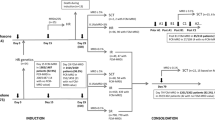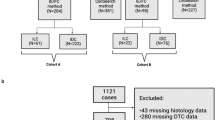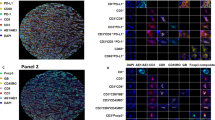Abstract
Flow cytometric (FCM) estimation of DNA content has been performed on tumour tissue from 197 patients with high and intermediate grade non-Hodgkin's lymphoma (NHL) to investigate the clinicopathological correlations and prognostic significance of DNA ploidy and proliferative activity. Fifty-one per cent of tumours were diploid; the remaining non-diploid tumours were near diploid (14%), aneuploid (28%) and tetraploid (7%). In 81 tumours multiple analyses were performed from different regions of the tumour, ploidy discrepancy was seen within the same tumour in 13/81 tumours (16%), and intra-tumour variation in proliferative index (PI) in 72 tumours was estimated at +/- 5%. Ploidy status did not correlate with histological subtype (Kiel or Rappaport), Ann Arbor stage or the site of disease at presentation. There was no significant difference in response rate, relapse-free survival (RFS) or overall survival rate between the different ploidy categories. Tumour proliferative index (PI) varied markedly between patients (range 2-51%, median 14%). A significant association was observed between PI and histological subtype in the Kiel classification (P = 0.001). The median PI for the lymphoblastic lymphomas was 20% compared with 10% for the centrocytic tumours. An elevated PI was significantly associated with a reduced rate (P = 0.023), with 71% of patients with a low PI (less than 20%) achieving complete remission (CR) compared with 49% patients with a high PI (greater than 20%). Despite this correlation with CR, PI was not significantly associated with overall survival. When the DNA data was combined with over 20 other potential prognostic factors in multivariate analysis, ploidy and proliferative activity did not prove to be of independent prognostic significance for response, RFS or overall survival. In 20 patients additional biopsy material was available from the site of subsequent relapse. In these cases, although the histology at relapse remained unchanged, ploidy status altered in 13/20 patients, and there was a significant rise in tumour PI at relapse compared with the initial pre treatment biopsy (P = 0.017). We conclude that in high and intermediate grade NHL, DNA ploidy as assessed using conventional FCM analysis is not significantly associated with clinical outcome. However, proliferative activity does correlate with histological subtype and response to therapy, and this parameter warrants further evaluation in future studies.
This is a preview of subscription content, access via your institution
Access options
Subscribe to this journal
Receive 24 print issues and online access
$259.00 per year
only $10.79 per issue
Buy this article
- Purchase on Springer Link
- Instant access to full article PDF
Prices may be subject to local taxes which are calculated during checkout
Similar content being viewed by others
Author information
Authors and Affiliations
Rights and permissions
About this article
Cite this article
Cowan, R., Harris, M., Jones, M. et al. DNA content in high and intermediate grade non-Hodgkin's lymphoma-prognostic significance and clinicopathological correlations. Br J Cancer 60, 904–910 (1989). https://doi.org/10.1038/bjc.1989.388
Issue Date:
DOI: https://doi.org/10.1038/bjc.1989.388
This article is cited by
-
Tumor proliferative activity and response to first-line chemotherapy in advanced breast carcinoma
Breast Cancer Research and Treatment (1996)



